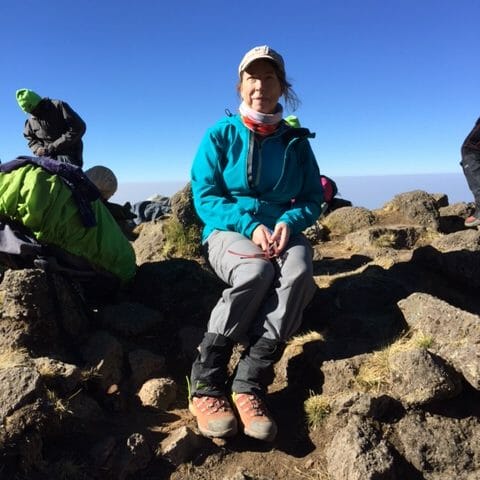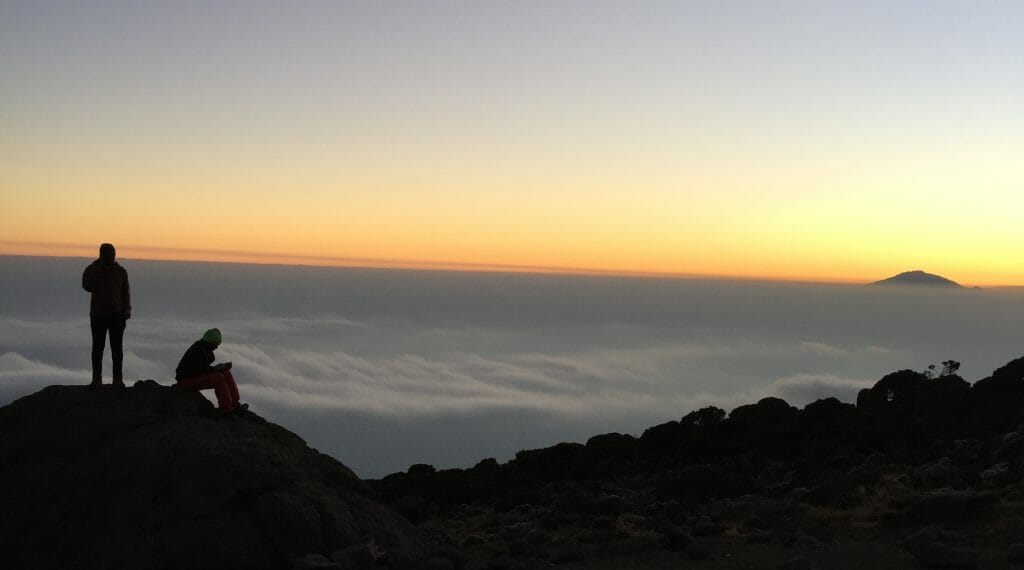To some people, climbing Kilimanjaro wouldn’t be a big deal. But to me, a 55-year-old lady from Oklahoma, it means a lot. Especially since the first time I tried it, I didn’t succeed.
My attempt on Kilimanjaro in 2016 wasn’t my first brush with climbing. I was pretty lucky to have a dad that was before his time in wanting his family to be outdoor oriented, and I fell in love with mountains as a child. But for one reason or another, my life kept taking these paths and deviations away from climbing. There was college, then medical school, then a five-year residency, which came with quite a few time and money constraints. And then I started my career at UT Southwestern and Baylor University Medical Center in Dallas, Texas. Eventually my father was diagnosed with Parkinson’s disease. As his conditioned progressed, it became apparent that I needed to move back to Oklahoma to help my family care for my dad.
Still, I did manage to get out whenever I could. I made a few trips to the Tetons and climbed Mount Moran, Baxter’s Pinnacle, and the Grand Teton. I climbed a little in Red Rocks. In 2008, I even climbed Denali with RMI.
In early 2016 I decided I would try to climb Kilimanjaro. I didn’t do all that much to train for it, I just figured I would be able to get by the way I always had before. A few months later, I found myself high on the mountain on summit day … falling apart. With every step, the rest of the group got farther and farther ahead of me. Eventually, I just had to stop. I was the only one on the team not to make the summit.
Fifteen years ago, I could get by with training errors. I could just pick up and do it. I wasn’t the strongest or fastest, but I was always able to get by. But between training errors, getting older, and being busier and busier with work and family, my old way of training just didn’t work on Kilimanjaro. I got shut down.
I knew something had to change. I was familiar with Steve and Scott from past seminars of theirs and guided climbs I had done with Steve, and I had a suspicion that they could help me out. So I went to Steve and Scott’s Mountain Performance Seminar in Boulder, and then in May of 2017, I asked Steve if he would coach me. I wanted to go back to Kilimanjaro, but this time, I wanted to go in better shape.
What followed was a well-prescribed four-month training program. I know it sounds crazy, but I really enjoyed it. I live in Tulsa, Oklahoma, and we don’t have too many big mountains nearby. So I did a lot of training inside. Not in a gym, though. I spent hour upon hour in a hot stairwell going up and down, up and down. Steve had me wearing my backpack, and as the weeks went by he gradually increased the weight I was carrying. It wasn’t always easy, but I could feel it making a difference.
After my first week of training I was in tears. Tears of happiness. Tears of hope. It had been so long since I had been able to string together consecutive workouts. I distinctly remember contacting Steve with this good news. I could tell he was happy for me.
And so on September 2017, after 22 hours on a plane, I found myself back on Kilimanjaro. But this time I felt really confident. The year before, I was full of insecurities. I kept wondering if I was going to slow the group down. This year, after my training with Steve, I didn’t have those concerns. I was really confident in my abilities, and it just made the climb so much more enjoyable. Fortunately it’s not the Rupal Face!
Even so, on summit day, I still found myself facing some nagging doubts. I was excited for the challenge. But I still had the normal trepidation that I think anyone has when you start going into altitude. Summit day out the gates is all uphill. You’re really high, a little over 19,300 feet, and I had a few minutes of panic. I really felt the lack of oxygen, and for a moment, I started to wonder if I would have to stop and turn around again. But I had a great guide who was really reassuring, and I kept thinking back to training. “Kathleen,” I told myself, “you can do this, you’ve done harder. You’ve put in the training. If you can plod up and down a stairwell for hours at a time, with no scenery, then certainly you can just keep putting one foot in front of another and do it here.”
And that’s exactly what I did. I just put one foot in front of another, and enjoyed the beauty of Kilimanjaro. I enjoyed hearing our African guides laughing and joking with one another. I was climbing with a wonderful group of people. Our guide was incredible. And just as important, I was enjoying the effects of great training.
All of a sudden, there I was on the summit. I felt like I was on top of the world. I was definitely feeling the altitude and the lack of oxygen. But psychologically I felt great. And amazingly, my legs felt good, too.
 To me, the story to be told here is that even a middle-aged lady can actually reclaim fitness and enthusiasm for the sport of climbing, and go to high altitudes, and do it with confidence. I used to think mountain climbers were just naturally strong, and that for the rest of us, the mountains were basically inaccessible. But it’s not true! You have more say in the matter than that. You can train yourself to perform out there, and you can enjoy opening up those physical, mental, and emotional doors that come with the territory. For many of us, that’s what climbing is: it’s a way to reconnect, to redefine yourself, to keep growing and evolving.
The best thing about Kilimanjaro is not that I stood on the summit of some mountain, but that now I have confidence to do other things. Steve recommended the East Ridge of Grand Teton. I never would have thought I could do something like that, but now I know that there is a way to make it happen. I believe in myself, and my abilities. For me that’s a big deal.
If there’s anything I hope people would take away from reading my story, it’s this: you can succeed in climbing mountains, even if it might seem impossible to you. You just have to be disciplined. You have to approach it intentionally. With great coaching, you can do it.
And if you can succeed in that, what else might you be able to achieve?
-by Uphill Athlete Kathleen Sisler
To me, the story to be told here is that even a middle-aged lady can actually reclaim fitness and enthusiasm for the sport of climbing, and go to high altitudes, and do it with confidence. I used to think mountain climbers were just naturally strong, and that for the rest of us, the mountains were basically inaccessible. But it’s not true! You have more say in the matter than that. You can train yourself to perform out there, and you can enjoy opening up those physical, mental, and emotional doors that come with the territory. For many of us, that’s what climbing is: it’s a way to reconnect, to redefine yourself, to keep growing and evolving.
The best thing about Kilimanjaro is not that I stood on the summit of some mountain, but that now I have confidence to do other things. Steve recommended the East Ridge of Grand Teton. I never would have thought I could do something like that, but now I know that there is a way to make it happen. I believe in myself, and my abilities. For me that’s a big deal.
If there’s anything I hope people would take away from reading my story, it’s this: you can succeed in climbing mountains, even if it might seem impossible to you. You just have to be disciplined. You have to approach it intentionally. With great coaching, you can do it.
And if you can succeed in that, what else might you be able to achieve?
-by Uphill Athlete Kathleen Sisler
 To me, the story to be told here is that even a middle-aged lady can actually reclaim fitness and enthusiasm for the sport of climbing, and go to high altitudes, and do it with confidence. I used to think mountain climbers were just naturally strong, and that for the rest of us, the mountains were basically inaccessible. But it’s not true! You have more say in the matter than that. You can train yourself to perform out there, and you can enjoy opening up those physical, mental, and emotional doors that come with the territory. For many of us, that’s what climbing is: it’s a way to reconnect, to redefine yourself, to keep growing and evolving.
The best thing about Kilimanjaro is not that I stood on the summit of some mountain, but that now I have confidence to do other things. Steve recommended the East Ridge of Grand Teton. I never would have thought I could do something like that, but now I know that there is a way to make it happen. I believe in myself, and my abilities. For me that’s a big deal.
If there’s anything I hope people would take away from reading my story, it’s this: you can succeed in climbing mountains, even if it might seem impossible to you. You just have to be disciplined. You have to approach it intentionally. With great coaching, you can do it.
And if you can succeed in that, what else might you be able to achieve?
-by Uphill Athlete Kathleen Sisler
To me, the story to be told here is that even a middle-aged lady can actually reclaim fitness and enthusiasm for the sport of climbing, and go to high altitudes, and do it with confidence. I used to think mountain climbers were just naturally strong, and that for the rest of us, the mountains were basically inaccessible. But it’s not true! You have more say in the matter than that. You can train yourself to perform out there, and you can enjoy opening up those physical, mental, and emotional doors that come with the territory. For many of us, that’s what climbing is: it’s a way to reconnect, to redefine yourself, to keep growing and evolving.
The best thing about Kilimanjaro is not that I stood on the summit of some mountain, but that now I have confidence to do other things. Steve recommended the East Ridge of Grand Teton. I never would have thought I could do something like that, but now I know that there is a way to make it happen. I believe in myself, and my abilities. For me that’s a big deal.
If there’s anything I hope people would take away from reading my story, it’s this: you can succeed in climbing mountains, even if it might seem impossible to you. You just have to be disciplined. You have to approach it intentionally. With great coaching, you can do it.
And if you can succeed in that, what else might you be able to achieve?
-by Uphill Athlete Kathleen Sisler 
